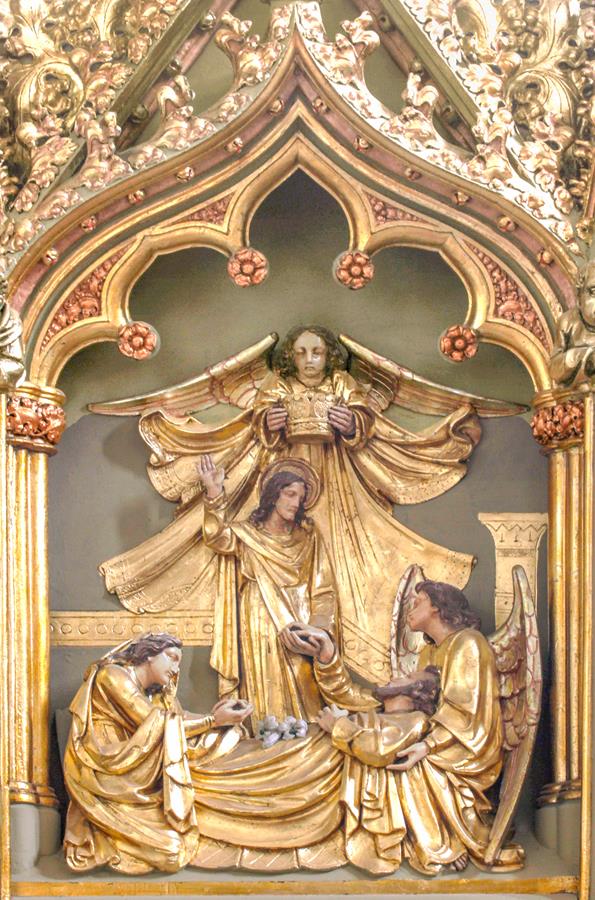
The St Joseph Chapel to the right of St Marie’s Sanctuary is also known as the Norfolk Chapel and is the family chapel for the Dukes of Norfolk, who continued in the Catholic faith and covertly supported the faith during and after the Reformation.
The Duke of Norfolk is the premier Duke and Earl in the English peerage and the family has been by far the major contributor to the construction and, latterly, the restoration of the Cathedral Church of St Marie.
The tiled floor bears the initials of the Norfolk family, surmounted by a ducal coronet, and the initials of ‘the Earl of Arundel and Surrey’ with the Lion of the House and the motto Sola Virtus Invicta (Virtue alone is victorious).
On the stone screen separating the Chapel from the Sanctuary is a request in Latin for prayers for the House of Norfolk.
There are three representations of Joseph in the Chapel – two carvings in the reredos, which dates back to 1877, was designed by Charles Hadfield and reputedly sculpted by Theodore John Baptiste Phyffers.
Phyffers was born in Belgium around 1820 and was recruited by Augustus Pugin, the English architect, designer, artist and critic, to carve models and provide guidance for artisans producing woodcarvings for the Pugin-designed new Houses of Parliament in London
In addition to Pugin, Phyffers worked on several projects with Matthew and Charles Hadfield and John Francis Bentley and carved the original High Altar and reredos in St Marie’s Sanctuary to Pugin’s designs.

The carvings at the top of the reredos in the St Joseph Chapel show Joseph on his deathbed, with Christ poised to welcome him into heaven. Panels on either side show the Archangels Michael and Gabriel.
Michael is sheathing his sword, symbolising the completion of task of guarding Joseph from danger in life, while Gabriel holds a finger to his lips, a reference to the strength of Joseph’s faith. When told of Mary’s pregnancy ahead of their formal marriage, Joseph was initially in favour of leaving her, but took her into his own home after being told to do so in a dream.
Joseph’s relative, Zechariah, on the other hand, when told by Gabriel in a vision, that his “barren” wife would give birth to the future John the Baptist, refused to believe and was struck dumb until he named his new born child John.

The central figure beneath the deathbed scene is St. Joseph holding a lily, a traditional symbol of purity and rebirth, which may also be used to signify virginity.
The Altar bears words from Psalm 42, Introibo Ad Altare Dei – I will go to the altar of God – the opening words of the Mass in Latin as it was celebrated at the time.
Along stone screen separating the chapel from the Sanctuary you will find tiling commemorating the work in Sheffield of the Sisters of Notre Dame.

The tiling to the right shows Joseph holding a lily, the Virgin Mary and, on the altar behind them, the Agnus Dei, or ‘Lamb of God’ A representation of Jesus who, by sacrificing his life on the cross, saves mankind from sin and death.
The image also evokes the idea of God shepherding his flock and, as is traditional, shows the Lamb with a pennant bearing a red cross on a white background resting on one shoulder and held by the Lamb’s cocked foreleg.
The cross pre-dates the Cross of St George. It was St George who became associated with the cross and not the other way round.
Below the image is a dedication to one of the Notre Dame sisters, which reads: “Of your charity pray for the soul of Sister Walstan of the Convent of Notre Dame and some time Warden of St Joseph‘s Guild, who departed March 2nd 1884 on whose soul Jesu have mercy. Amen.”
The tiling to the left shows seven saints, six of whom are also represented in the tiling on the right hand wall of the chapel – Saints Agnes, Barbara, Catherine, Clare, Elizabeth and Margaret. The chapel also contains statues representing Saints Winifrede (Sanctuary side), Rose of Lima, Margaret and Hilda of Whitby (opposite).

